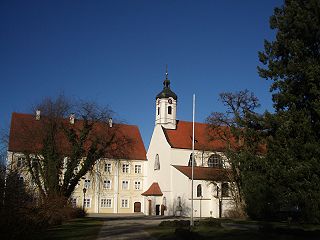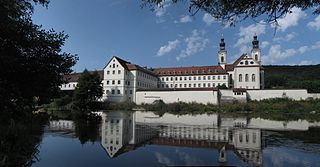
Sankt Bernhard Abbey (German : Stift Sankt Bernhard) is a former Cistercian nunnery in Sankt Bernhard-Frauenhofen in Lower Austria.

Sankt Bernhard Abbey (German : Stift Sankt Bernhard) is a former Cistercian nunnery in Sankt Bernhard-Frauenhofen in Lower Austria.
In 1277, the Cistercian nunnery previously located in Neumelon was relocated onto land in Chrueg im Pewreich am Teffenbach (the modern Sankt Bernhard) which Stephan von Maissau had donated for this purpose. He was married to Margarete von Neuhaus, a member of the noble family of Hradec, whose sister was the abbess here in 1285.
The abbey was dissolved in 1580 during the Reformation and in 1586, the building and its grounds were granted to the Jesuit college in Vienna. After the college was in turn dissolved in 1773, the former abbey passed through a number of private hands and began to decay, until it came into the possession of Klosterneuburg Priory in 1852 following the death of the Freiherr von Ehrenfels. In 1947, the abbey church was renovated. In 1961 the chapter house along with the remains of the cloister were removed to Klosterneuburg Priory.
Coordinates: 48°41′07″N15°35′42″E / 48.68528°N 15.59500°E
Biburg Abbey was a house of the Benedictines located at Biburg in Bavaria, Germany.

Neuburg Abbey near Heidelberg in Baden-Württemberg is a Benedictine monastery dedicated to Saint Bartholomew, and part of the Beuronese Congregation.

Saint Blaise Abbey was a Benedictine monastery in the village of St. Blasien in the Black Forest in Baden-Württemberg, Germany.
St. George's Abbey in the Black Forest was a Benedictine monastery in St. Georgen im Schwarzwald in the southern Black Forest in Baden-Württemberg, Germany.

Gutenzell Abbey was a Cistercian nunnery in the municipality of Gutenzell-Hürbel in the district of Biberach, Baden-Württemberg, Germany.

Lucelle Abbey or Lützel Abbey was a Cistercian monastery in the present village of Lucelle, in the Haut-Rhin department in Alsace, France, but located right on the Swiss border.

Wechterswinkel Abbey was a Cistercian nunnery in the small village of Wechterswinkel, a part of Bastheim in the mountainous region of the Rhön in Bavaria, Germany, in the Bishopric of Würzburg.

Oberschönenfeld Abbey is a Cistercian nunnery in Gessertshausen in Bavaria, Germany.

Göss Abbey is a former Benedictine nunnery and former Cathedral in Göss, now a part of Leoben in Styria, Austria. After the abbey's dissolution in 1782 the church, now a parish church, was the seat of the short-lived Bishopric of Leoben.

Swine Priory was a priory in the village of Swine in the East Riding of Yorkshire, England. The site of the Cistercian nunnery is a Scheduled Monument.
Pinley Priory, also called Pinley Abbey, was a Cistercian nunnery in the parish of Rowington in Warwickshire, England. It was founded in the early 12th century and dissolved in 1536.
Bottenbroich Abbey, later Bottenbroich Priory, was a former Cistercian religious house located in Bottenbroich, now in Frechen, about three kilometres north-east of Kerpen, in the present Rhein-Erft-Kreis of North Rhine-Westphalia, Germany.

Pielenhofen Abbey is a former Cistercian nunnery, in Pielenhofen in the valley of the Naab, Bavaria, Germany. It was occupied until 2010 by the Visitandines, also known as the Salesian Sisters. The Diocese of Regensburg maintains a school here.

Himmelthal Abbey was a Cistercian nunnery in Elsenfeld in Bavaria. It was founded by 1232 by Count Ludwig II von Rieneck and his wife Adelheid von Henneberg. It had ceased to function by 1568, when the Archbishopric of Mainz dissolved it and used the premises as a Kameralhof. It was then used by the Jesuits from 1595 and formally passed to them in 1626. After the German Jesuits were dissolved in 1773, the estate reverted to the Archbishopric of Mainz, which assigned it to an educational establishment. Since 1814 it has been owned by the Gymnasiumsfonds des Stiftungsamtes Aschaffenburg. Some 18th-century panels showing the organisation's holdings are now in the Stiftsmuseum of Aschaffenburg.